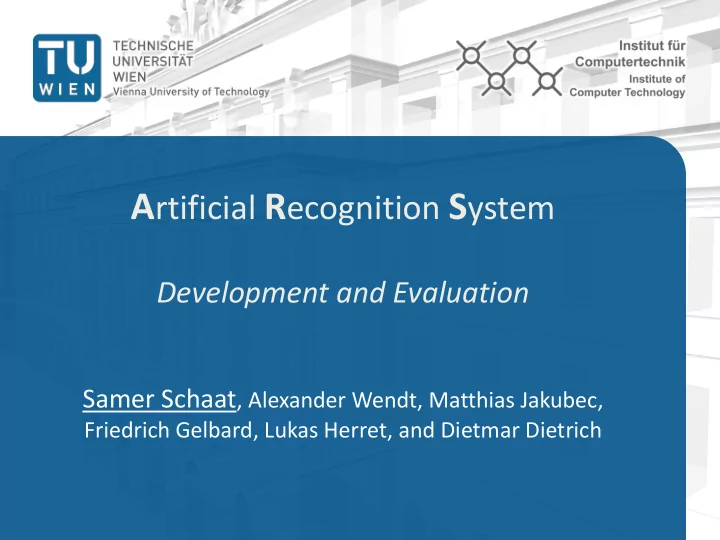

www.ict.tuwien.ac.at A rtificial R ecognition S ystem Development and Evaluation Samer Schaat , Alexander Wendt, Matthias Jakubec, Friedrich Gelbard, Lukas Herret, and Dietmar Dietrich Institute of Computer Technology /15
www.ict.tuwien.ac.at Artificial Recognition System (ARS) Project General-purpose model of human information processing for the usage in various artificial systems Human-Robot Interaction (Kismet) Evacuation Simulation (ESCAPES) Humanoid agents in a virtual world Body Psyche Decision unit (ARS model) Institute of Computer Technology Samer Schaat 2 /15
www.ict.tuwien.ac.at Key Features of the ARS Approach Functional model Generative approach: describing functions not behavior generic, flexible Layered description model Appropriate means of description for different aspects (neurons, neurosymbolics, psyche) Holistic and unitary model Consistent and coherent integration of basic aspects (motivation, emotion, planning…) Top-down approach Concretize abstract functions incrementally, starting with psychic layer Bionic and interdisciplinary approach Translate knowledge into technical models Institute of Computer Technology Samer Schaat 3 /15
www.ict.tuwien.ac.at Basic question: How to develop and evaluate such a model? Institute of Computer Technology Samer Schaat 4 /15
www.ict.tuwien.ac.at Challenges Restricted accessibility of mind’s functioning Interdisciplinary understanding and knowledge translation Complexity in description and explanation Institute of Computer Technology Samer Schaat 5 /15
www.ict.tuwien.ac.at Restricted Accessibility of the Mind Various ways to get information about the mind’s functioning Relevant knowledge for our objective? Right level (psyche)? Cannot be used directly Interpretation and knowledge translation required Experts needed http://de.wikipedia.org/wiki/Elektroenzephalografie Institute of http://homepages.uni-tuebingen.de/karnath/Research.html Computer Technology Samer Schaat 6 /15 http://www.edgehill.ac.uk/psychology/research-participation/
www.ict.tuwien.ac.at Interdisciplinary Understanding Regular, intensive collaboration Different concepts, vocabulary….? 7 Institute of http://variationsphase.de/vp/2012/10/misunderstanding/ Computer Technology Samer Schaat /15
www.ict.tuwien.ac.at Complexity and Explanation Right level, relevant knowledge? Not only on neuronal level, also on psychic level Interplay of various factors determine behavior Institute of http://medtech-news.com/?p=38 Computer Technology Samer Schaat 8 /15
www.ict.tuwien.ac.at Case-driven Agent-based Simulation Combination of Casuistics for interdisciplinary collaboration • UC-based requirement analysis for deterministic structuring • Agent-based simulation as a evaluation framework • Institute of Computer Technology Samer Schaat 9 /15
www.ict.tuwien.ac.at Step 1: Describe phenomena and assumptions Platform and tool for interdisciplinary collaboration Exemplify and discuss research question with a concrete exemplary case e.g. How two hungry agents behave in front of a food source (eat, share…) Enables stating (and testing) concrete assumptions (e.g. the role of emotions, drives, and norms) Avoids drifting into abstract discussions Embodies and integrate theories from different disciplines to explain behavior State of the art, experts‘ interpretation of real world conditions But: indeterministic, gaps in assumptions, inconsistent no direct usage Institute of Computer Technology Samer Schaat 10 /15
www.ict.tuwien.ac.at Step 2: Analysis and Structuring Clarify the exemplary case Explication of assumptions • Consistent description • Structure to deterministic description Causal function description • Data determinants of behavior • ( Memories, personality, environment, internal state ) Simulation-case (SC) enables Requirements analysis • Computational model • Test plan for evaluation • Institute of Computer Technology Samer Schaat 11 /15
www.ict.tuwien.ac.at Step 3: Data and Functional Model Previous steps enable • Requirements statement • Algorithmic description of functions • Modelling of knowledge representation Specify function modules, interfaces, data Adaption or extension? Implemented in MASON (Java) and Protégé (Ontology) Institute of Computer Technology Samer Schaat 12 /15
www.ict.tuwien.ac.at Step 4: Evaluation Simulation-case as test-template parameterize simulation according to scenarios Does the functions generate and data determine behavior as expected? How is the behavior generated? Test our hypotheses’ predictability Are the assumptions of exemplary case valid? • Does the interplay of specified factors (e.g. emotions, drives, norms) • generate the expected behavior? Does the specified data determine behavior (change)? • Unexpected behavior or state analysis on different levels feedback cycles Institute of Computer Technology Samer Schaat 13 /15
www.ict.tuwien.ac.at Conclusion Feedback cycles Possibility a, b: mistake in model translation • Possibility c: inconsistent in or between theories • Bridge disciplines, test knowledge translation Concretize testable assumptions from other disciplines Structure interdisciplinary knowledge to a causal model and test plan SC scenarios model calibration Stable model? sensitivity analysis! Premises for model application in specific domains Outlook Institute of Computer Technology Samer Schaat 14 /15
www.ict.tuwien.ac.at Thank you! Institute of Computer Technology Samer Schaat 15 /15
Recommend
More recommend